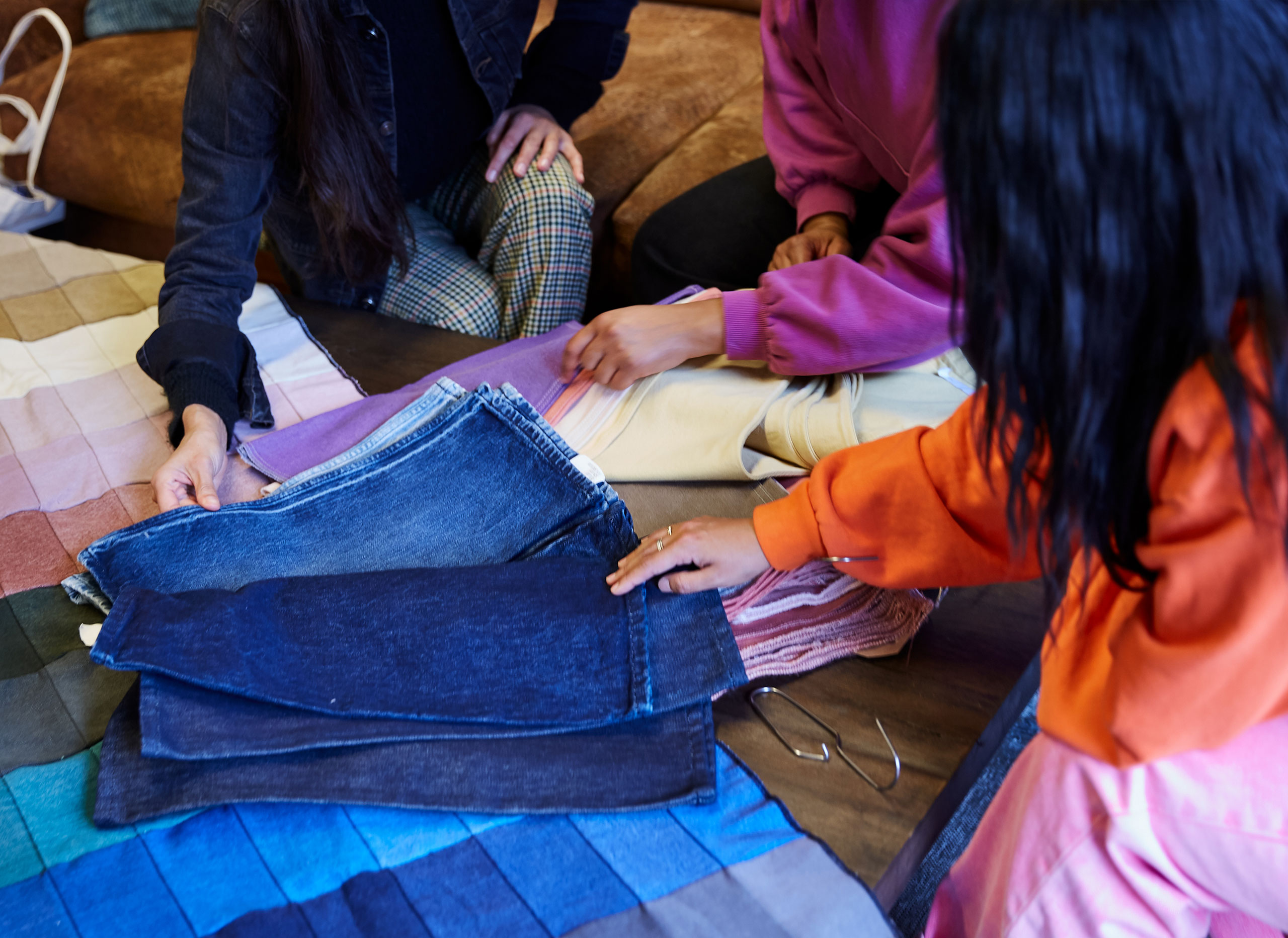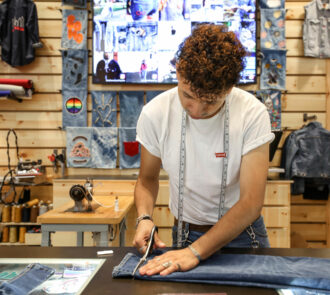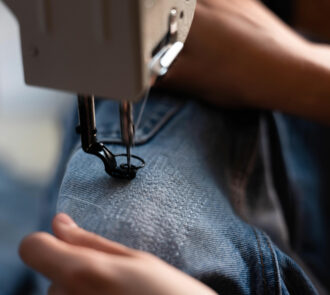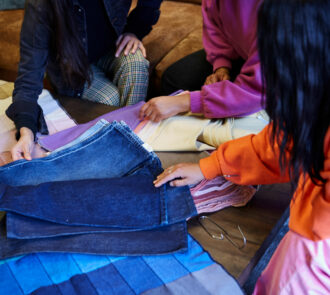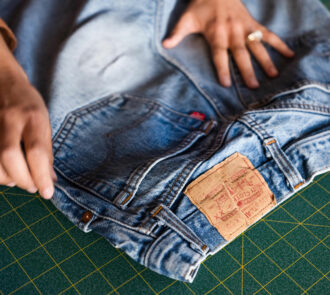Organic Cotton
Organic cotton is grown without the use of toxic and persistent pesticides or fertilizers, unlike conventional cotton, which uses both. The impacts to human and environmental health associated with conventional cotton agriculture are well documented, and life cycle studies by the Textile Exchange showed that organic cotton production can save water compared to conventionally grown cotton. We are committed to supporting organic cotton production and sourcing organic cotton for our WellThread® collection, Levi’s® Red Tab™ and some Dockers® products. The organic cotton we source is third-party certified to the Organic Content Standard (OCS) or Global Organic Textile Standard (GOTS).
As demand for organic cotton has grown, there have been challenges to global supply. Organic cotton makes up a small percentage of the global cotton supply and the discovery of falsely certified organic cotton in India and of forced labor in the Chinese supply chain have limited the organic cotton supply. This situation has recently led to other developments, such as the largest certification body that certifies organic cotton in India announcing they will no longer certify, as well as our internal ban on any cotton sourced from China’s Xinjiang province. LS&Co. is following a plan to incrementally increase our use of organic cotton to manage these challenges, but only with the highest level of integrity and attention to the quality of actual practices on the ground in organic cotton growing regions. We are also participating in collaborative platforms to advance the organic cotton industry, starting at the farm level.
Better Cotton
LS&Co. is a founding member of BCI and joined the initiative in 2010. BCI’s vision is to transform the cotton-producing sector by enabling more sustainable agricultural practices such as reduced water consumption, chemical use at the field level and increased market access for farmers. By aligning environmental and financial sustainability, reducing market barriers through a mass balance system and working with stakeholders at every stage of the supply chain, BCI has shown an exceptional ability to scale. By the end of the 2020-2021 cotton growing season (defined by BCI as July 2020 – August 2021), Better Cotton accounted for 10% of global cotton production and 2.2 million licensed BCI farmers produced 4.7 million metric tons of Better Cotton
During the COVID-19 pandemic, BCI was able to work through its network of implementation partners and licensed farmers to provide personal protective equipment, updates on the pandemic and safety advice to remote cotton farming communities. For LS&Co., participating in BCI as a member and supporting Better Cotton demonstrates our commitment to improving cotton farming on a global scale, supporting farmers’ livelihoods and driving environmental improvements at the field level.
U.S. Cotton Trust Protocol
In 2021, we joined the U.S. Cotton Trust Protocol, a farm-level, science-based program setting a new standard for more sustainably grown cotton. We also serve on the Trust Protocol Board of Directors as a representative of apparel retailers. Specifically, the Trust Protocol strives to bring quantifiable goals with verified impact to sustainable cotton production. The Trust Protocol offers several opportunities for us to drive more sustainable and transparent cotton cultivation. It supports ongoing efforts to make U.S. cotton production more sustainable, further diversifies our cotton portfolio, offers verified data in six sustainability metrics, and provides a trackable cotton supply chain for all members. These benefits promise to help us measure progress toward our water and climate targets and communicate the impact of this work publicly.
Our participation in the Trust Protocol supports greater sustainable practices in the U.S. It aligns with our global sustainable fiber priorities and our participation will allow us to further diversify our more sustainable cotton portfolio, which is prudent given how much cotton we use. Our initial work with the Trust Protocol has included a pilot with a number of mills that support LS&Co. in the Americas. We are also participating in the pilot phase of the Protocol Credit Management System, which uses blockchain technology to record and verify the movement of U.S. cotton fiber along the entire supply chain.
Pioneering Fiber Innovations
Cottonized Hemp
Hemp requires less water and fewer pesticides to grow but had traditionally felt too coarse on the skin for unaltered use in denim. We worked with other innovators to devise a way to soften rain-fed hemp so that it feels like cotton. This advancement aligns with our commitment to safer chemicals in the apparel supply chain and to responsible stewardship of the resources required to make our products.
Both Levi’s® WellThread® collections and mainline products have featured cottonized hemp, bringing the environmental benefits and comfort of soft hemp to even more consumers. Innovating and scaling the use of alternative fibers like cottonized hemp are key steps along the way to delivering more sustainable apparel. In 2021, we launched cottonized hemp in Dockers® products. While it was a small part of the 2021 Dockers® fiber makeup, we look forward to being able to incorporate more of this water-saving fiber in the future.
Recycled Fibers
While we continue to explore the use of recycled denim and other cotton fabrics such as those in t-shirts and other tops, limitations on the strength and durability of recycled cotton fibers pose challenges. Each time a cotton textile is recycled, its fibers become shorter, which reduces strength. We are trying to achieve the right balance between recycled cotton and virgin cotton in any given fabric to meet our standards for strength and durability — which are not only required to meet our quality requirements but are key tenets of our circular apparel approach.
Responsible Manmade Cellulosic Fibers
Fibers like viscose, modal and lyocell are produced using wood pulp. The sourcing of wood as well as the fiber manufacturing processes can have significant impacts on the environment, from air and water quality to biodiversity. The sustainable production of manmade cellulosic fibers provides opportunities to tackle some of the apparel industry’s sustainability challenges and contribute to building resilience, accelerating regeneration and supporting a circular economy. We continue to address the impacts of wood-based fiber production by sourcing 100% of our manmade cellulosic fibers from responsible supply sources, as rated by Canopy.
Back in 2019, LS&Co. completed the shift of all manmade cellulosic fibers — viscose (rayon), modal, and lyocell — to suppliers earning a Canopy “Green Shirt” rating with a minimum of 25 buttons in Canopy’s Hot Button Ranking, which requires eliminating sourcing from Ancient and Endangered Forests. In this move, we transitioned away from generic viscose to traceable viscose and expanded our use of lyocell, such as Lenzing’s Tencel™ fiber, which continually recycles the chemical solvents used to produce the fiber and requires less energy and less water than generic viscose.* In FY21, we accepted manmade cellulosic fibers from the companies Lenzing, Birla, Tangshan Sanyou (for Circulose® fiber) and Kelheim.** All manmade cellulosic fiber suppliers to LS&Co. must be Canopy Green Shirt-rated and committed to responsible manufacturing.
We source sustainable wood-based fibers consistent with our CanopyStyle commitment to work with suppliers to prevent wood-based materials from the world’s Ancient and Endangered Forests from entering our supply chain. Our work to address the impacts of manmade cellulosic fiber manufacturing is consistent with our Commitment to Zero Discharge of Hazardous Chemicals. It is also aligned with the Changing Markets Roadmap.
*Tencel™ is a trademark of Lenzing Aktiengesellschaft.
**Circulose® is a registered trademark of Re: NewCell AB.
Next-Generation Fibers
About two-thirds of the manmade cellulosic fibers used in our products are lyocell fibers, created with closed-loop manufacturing processes that recover and reuse chemicals and water. This drastically reduces the environmental impacts and natural resources required for production. We are also incorporating the pioneering REFIBRA™ technology, which involves upcycling cotton scraps from garment production into our products.* These cotton scraps are transformed into cotton pulp and added to wood pulp, with the combined raw material resulting in new Tencel™ Lyocell fibers to make fabrics.
*REFIBRA™ is a trademark of Lenzing Aktiengesellschaft.
To further advance progress toward next-generation manmade cellulosic fibers, we participate in the Vision for the Future of Manmade Cellulosic Fibers initiative, a collaborative venture of the Forum for the Future and Textile Exchange. This multi-stakeholder program lays out five interdependent components for regenerating ecosystems, producing fibers with zero harm, enabling circular systems, creating prosperity and upholding rights in the value chain. We see participation in visionary collaborations like this one as important building blocks in our industry’s journey to next-generation fibers that not only eliminate harm, but also offer the potential to regenerate ecosystems and strengthen biodiversity.
Animal Welfare
As detailed in our Animal Welfare Policy, updated in 2021, LS&Co. aims to ensure that wherever materials derived from animals are used in the production of our products, their health and welfare is protected. Our suppliers are expected to use the international industry best practices known as the Five Domains for Animal Welfare. Additionally, we prohibit the use of animal-derived products and materials from any endangered species as identified by the International Union for Conservation of Nature (IUCN) Red List. We do not accept wool from mulesed sheep and we are working to ensure all virgin wool in new LS&Co. products will be Responsible Wool Standard-certified by 2025.
We are committed to the principles of the Responsible Down Standard (RDS) and 100% of our down products are certified to the standard. In 2021, we joined the Leather Working Group (LWG) to support responsible leather processed using best practices by environmentally certified leather suppliers. That same year we began using some leather for footwear and accessories from Leather Working Group-certified sources. In FY21, more than 35% of the leather we sourced came from LWG-rated suppliers for footwear and accessories, a number we are working to expand over time. With many supplier partners along the chain of custody, it can be difficult to determine the exact origin of leather. We have evaluated the use of leather in our backpatches to see how we might further increase our visibility into the leather supply chain. In 2022, we will work with our suppliers to assess the animal welfare of cattle in our supply chain using the Royal Society for the Prevention of Cruelty to Animals (RSPCA) beef cattle welfare standard.
Synthetic Fibers
Synthetic fibers like polyester can help to enhance product performance. And while they are a small portion of the LS&Co. fiber portfolio, we are committed to reducing our use of virgin synthetics through recycled fibers. For instance, Dockers® continues to use recycled polyester and is also working to shift away from synthetics by collaborating with suppliers to bring sustainability attributes into other performance fibers.
Dockers® incorporates polyester for moisture wicking, strength and other performance properties. The brand launched its new Dockers® Rec collection with a variety of products — tops, shorts and pants— featuring recycled fibers. For instance, REPREVE®, a recycled polyester madefrom plastic bottles and traceable through the UTRUST certification program, was used in the Dockers® Rec collection for men’s hiking shorts and utility pants.*
*REPREVE® is a registered trademark of Unifi, Inc.
Certification
Certification is the last step in the process of traceability and assuring the integrity of more sustainable fibers. It reflects third-party verification of fiber content, chain of custody, social and environmental practices, and other attributes. Certifications align definitions of certain characteristics, such as organic content, recycled content, safer chemical use and others. LS&Co. uses the Textile Exchange Certifications — Organic Content Standard, Global Recycled Standard, Recycled Claim Standard, Responsible Down Standard, Responsible Wool Standard and others — and the Preferred Fibers and Materials list to define our “more sustainable materials.” We define “more sustainable” materials as those that have achieved the related third-party certification or verification.
One exception is hemp. Still considered an innovative fiber, hemp is not yet certifiable, but its significant sustainability potential is gaining recognition. We worked with third parties to substantiate water and chemical use reductions associated with hemp cultivation and the process we use for our cottonization, or softening, of hemp. We are working with industry associations such as the Sustainable Apparel Coalition to recognize hemp as a more sustainable material.
During 2021, we worked extensively to substantiate water and chemical use considerations associated with innovative fibers, materials and input for dye processes. This included making sure the bio-based fibers we source are not food turned into textiles and are grown with responsible land-use practices. We engaged a third party to identify ways to substantiate our claims regarding water and chemical use with a high degree of confidence. During the year, we began pursuing brand-level certification to the Organic Content Standard (OCS), the Recycled Claim Standard (RCS) and the Global Recycled Standard (GRS). These certifications would be in addition to the existing Responsible Down Standard (RDS) certification we rely on for responsibly sourced down. Already, our company-operated factory in Plock, Poland, is certified to develop products under the OCS.


